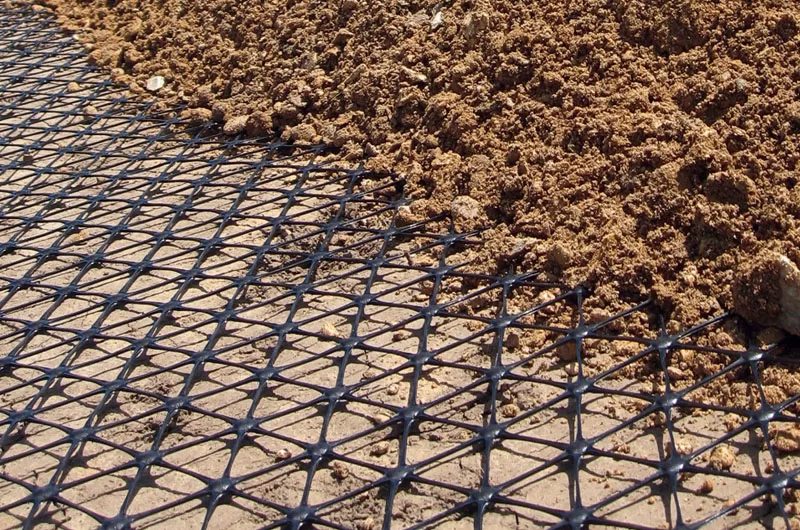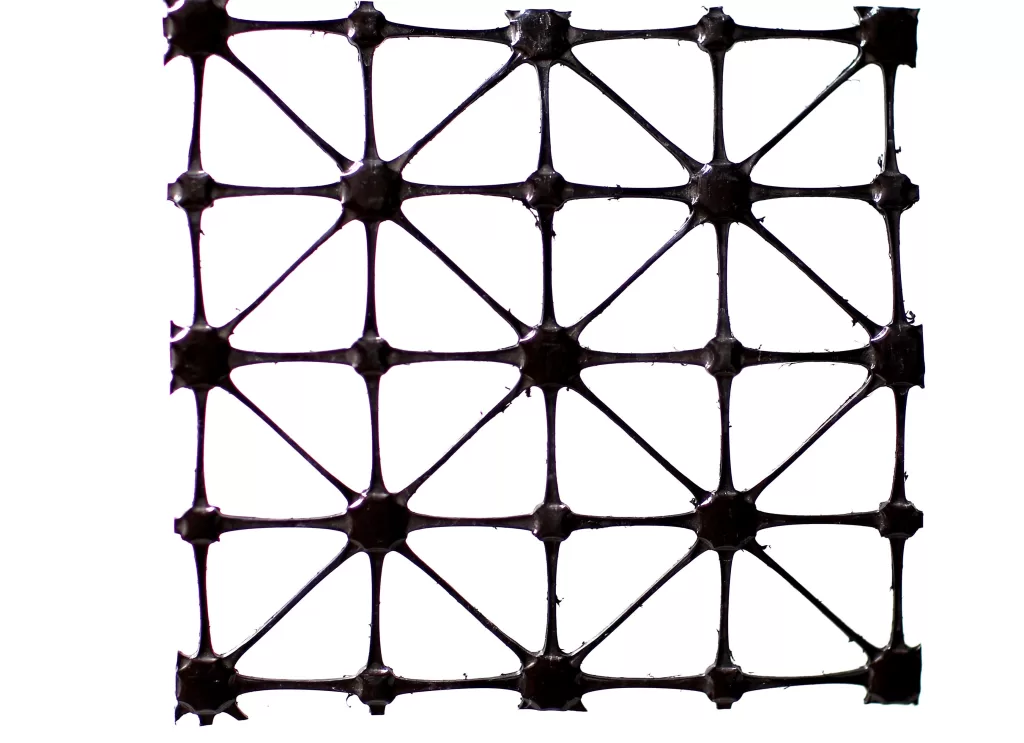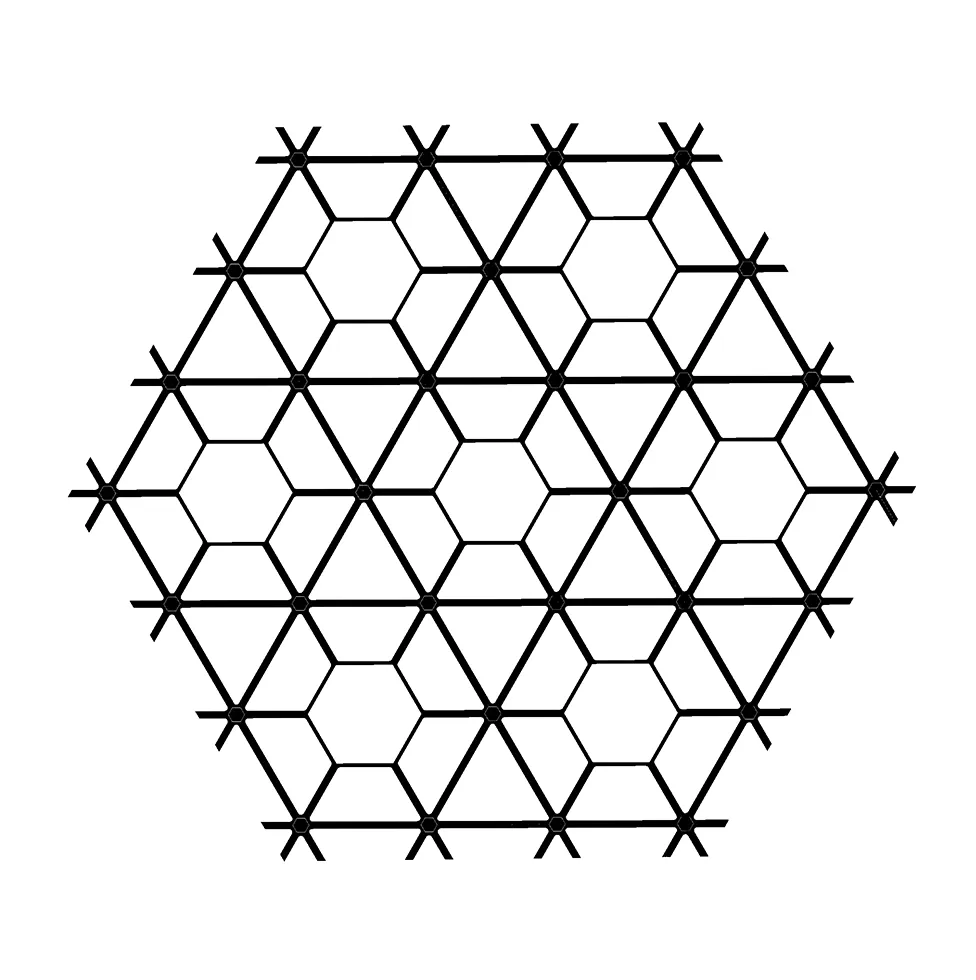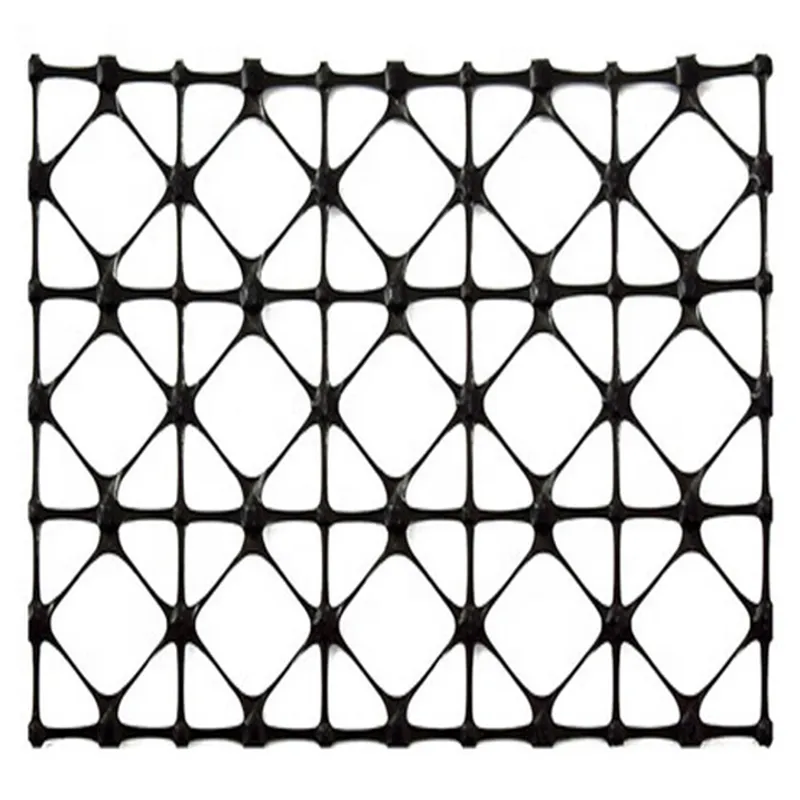+86-159 9860 6917
info@geofantex.com
geofantex@gmail.com
+86-400-8266163-44899
Geogrid soil stabilization is a critical engineering method that enhances the stability and strength of soil, especially in construction and landscaping. These grid-like materials, made from polymers such as polyester or polypropylene, create a structured foundation that reinforces the soil, making it more resistant to erosion, load pressures, and environmental wear. This process is especially valuable on slopes, roads, and areas with challenging soil conditions. In this article, we explore how geogrids contribute to soil stabilization, their practical applications, and when to choose geogrids over geotextiles.
What is slope stabilization with Geogrid?
Definition and Significance of Slope Stabilization: Slope stabilization is a critical engineering practice designed to prevent landslides, erosion, and other forms of slope failure. This is achieved by reinforcing slopes to make them more stable and resistant to natural forces like gravity, water runoff, and seismic activity. The significance of slope stabilization is profound in civil engineering, as unstable slopes can lead to road closures, property damage, and even loss of life. Additionally, slope stabilization is essential for protecting the environment, particularly in areas prone to landslides or erosion, which can disrupt ecosystems and pollute water bodies.
What is Geogrid?
Geogrid is a type of geosynthetic material primarily used to reinforce soil and improve its structural integrity. Made from synthetic polymers such as polyester, polyethylene, or polypropylene, geogrids have a grid-like structure designed to interlock with soil particles. This unique design increases the material’s tensile strength and allows it to resist deformation. Geogrids come in different types based on their strength and intended use, including:
- Uniaxial Geogrid: Primarily used for reinforcing soil in one direction, like in retaining walls or steep slopes.
- Biaxial Geogrid: Provides strength in two directions, ideal for applications like base stabilization and road construction.
- Triaxial Geogrid: Has even greater strength in all directions, typically used in highly demanding applications like large-scale slope stabilization.
How Geogrid is Used in Slope Stabilization
Geogrids are used in slope stabilization to enhance soil strength, reduce erosion, and prevent slope failure. They are commonly used in both new slope construction and the reinforcement of existing slopes. Here’s how geogrid is typically used:
- Installation Methods: The process involves placing geogrid materials into the soil or rock layers at specific intervals. The geogrid is often embedded within the slope’s soil to create a reinforced system. In some cases, it may be placed between layers of soil to prevent sliding or movement of the soil mass.
- Best Practices: Proper installation is key to ensuring the effectiveness of geogrid reinforcement. This includes ensuring the geogrid is properly tensioned, ensuring correct overlap between geogrid layers, and proper anchoring to prevent slippage. Additionally, soil conditions (e.g., moisture content, compaction) must be carefully considered during installation.
Real-World Applications of Geogrid in Slope Stabilization
Several successful geogrid applications highlight its effectiveness in stabilizing slopes:
- Highway and Railway Slopes: In areas prone to landslides, geogrids have been used to stabilize slopes along highways and railways, preventing soil erosion and slope failure. For example, projects in mountainous areas, like the installation of geogrid-reinforced embankments, have protected transportation infrastructure.
- Landfills: Geogrids are often used in landfill construction to prevent slope collapse and ensure the stability of waste containment structures.
- Retaining Walls: In urban areas, geogrids are used to build reinforced earth walls for slope stabilization, especially where limited space is available.
Benefits:
- Increased soil strength and resistance to erosion.
- Cost-effective compared to traditional methods.
- Reduced construction time and material costs.
Challenges:
- Soil conditions must be optimal for installation.
- Initial costs of geogrid materials can be higher than traditional methods.

Why is Geogrid used?
Geogrids are a critical component in modern civil engineering, often used in construction for their ability to enhance the strength and stability of soil structures. Below is a detailed breakdown of geogrid use, their functions, materials, and mechanisms.
Geogrids are geosynthetic materials made from polymers and are used primarily in soil stabilization and reinforcement. They are commonly deployed in projects involving road construction, earthworks, embankments, and erosion control. Their structure consists of a grid-like pattern of apertures, which allows them to interlock with the surrounding soil or aggregate material.
Functions of Geogrids
- Soil Stabilization: Geogrids reinforce soil, preventing shifting and settling. They create a structure that redistributes the load and enhances the bearing capacity of the soil, preventing failure due to compaction or erosion.
- Reinforcement of Roadways: They are particularly useful in reinforcing roads and pavements, especially in areas with weak or expansive soils. Geogrids help increase the longevity of roadways and reduce maintenance costs by minimizing rutting and cracking.
- Erosion Control: In erosion-prone areas, geogrids can help prevent the displacement of soil, stabilizing slopes and embankments and reducing the risk of washouts. They also improve water drainage by providing a more stable base for vegetation.
Types of Geogrids
- Uniaxial Geogrids: These geogrids have strength in one direction and are primarily used for applications where reinforcement is required in a specific direction, such as slope stabilization or load-bearing foundations.
- Biaxial Geogrids: These have strength in two perpendicular directions and are widely used for base reinforcement, including in road and railway construction, where the load is more evenly distributed.
- Triaxial Geogrids: These offer strength in three directions and are used in highly demanding applications such as supporting larger structures or reinforcing large embankments.
Mechanisms of Action
Geogrids function primarily through the following mechanisms:
- Load Distribution: The grid structure helps distribute applied loads evenly across the soil, improving its overall bearing capacity.
- Soil Interlocking: The apertures in the geogrid mesh interlock with surrounding soil or aggregates, preventing movement and increasing shear strength.
- Reinforcement: Geogrids reinforce the soil by creating a cohesive structure that resists deformation under load, reducing the risk of subsidence or cracking in paved surfaces.
Case Studies and Examples
- Road Construction: A case study in Arizona, USA, involved the use of biaxial geogrids in road construction where the subgrade was particularly weak. The implementation of geogrids led to improved road performance, with reduced rutting and extended road lifespan.
- Slope Stabilization: In a project in Switzerland, triaxial geogrids were used in a landslide-prone area to stabilize the slope. The project demonstrated a significant reduction in soil erosion and a decrease in landslide incidents.
Geogrids are essential in modern civil engineering for enhancing the performance of infrastructure. Their ability to stabilize soil, improve the longevity of roads, and reduce erosion makes them a valuable tool. Understanding their functions, types, and mechanisms is key for selecting the appropriate geogrid for specific applications.
What is geogrid, and how is it used in soil stabilization?
A geogrid is a synthetic material with a grid-like pattern used to strengthen and stabilize soil by providing a reinforcing structure that interlocks with the soil. Its open-cell structure allows it to create a reinforcing matrix that enhances the soil
’
s natural properties. Geogrid is used to stabilize soil, and the material is laid flat over the ground or within layers of soil. This process interconnects the soil particles, which reduces movement and improves the soil’s load-bearing capability. Geogrids are commonly used in projects such as base reinforcement for roads, retaining wall support, and erosion control on slopes, as they effectively distribute weight and prevent soil shifting.
When should you use geogrids rather than geotextiles?
Used primarily for soil reinforcement, geogrids are preferable to geotextiles when projects demand high tensile strength and reinforcement in specific directions, such as in load-bearing applications and slope stabilization. While geotextiles are used primarily for separation and filtration (such as in drainage systems), geogrids are designed to reinforce soil by providing structural support. For example, in road and railway construction, where stability is crucial, geogrids are often chosen over geotextiles. Additionally, geogrids excel in stabilizing steeper slopes, as their grid structure is better suited to hold soil in place and handle stress distribution.
Geogrid soil stabilization plays a crucial role in modern construction and landscaping, providing essential support and preventing soil erosion in areas with challenging terrain. By reinforcing the soil and distributing weight, geogrids create a stable base for various infrastructure projects, from roads to retaining walls. While geotextiles are valuable for filtration and separation, geogrids are the material of choice when structural support and tensile strength are required. Using geogrid in slope stabilization is an effective method for ensuring stability, making it a valuable asset in areas prone to erosion and landslides.



Get Free Sample
We’ll respond as soon as possible(within 12 hours)






















